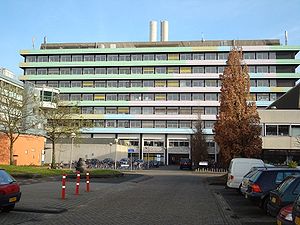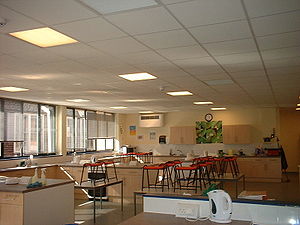
Food technology
Encyclopedia


Early history of food technology
Research in the field now known as food technology has been conducted for decades. Nicolas AppertNicolas Appert
Nicolas Appert , was the French inventor of airtight food preservation. Appert, known as the "father of canning", was a confectioner.-Biography:...
’s development in 1810 of the canning
Canning
Canning is a method of preserving food in which the food contents are processed and sealed in an airtight container. Canning provides a typical shelf life ranging from one to five years, although under specific circumstances a freeze-dried canned product, such as canned, dried lentils, can last as...
process was a decisive event. The process wasn’t called canning then and Appert did not really know the principle on which his process worked, but canning has had a major impact on food preservation techniques.
Louis Pasteur
Louis Pasteur
Louis Pasteur was a French chemist and microbiologist born in Dole. He is remembered for his remarkable breakthroughs in the causes and preventions of diseases. His discoveries reduced mortality from puerperal fever, and he created the first vaccine for rabies and anthrax. His experiments...
's research on the spoilage of wine
Wine
Wine is an alcoholic beverage, made of fermented fruit juice, usually from grapes. The natural chemical balance of grapes lets them ferment without the addition of sugars, acids, enzymes, or other nutrients. Grape wine is produced by fermenting crushed grapes using various types of yeast. Yeast...
and his description of how to avoid spoilage in 1864 was an early attempt to put food technology on a scientific basis. Besides research into wine spoilage, Pasteur did research on the production of alcohol
Alcohol
In chemistry, an alcohol is an organic compound in which the hydroxy functional group is bound to a carbon atom. In particular, this carbon center should be saturated, having single bonds to three other atoms....
, vinegar
Vinegar
Vinegar is a liquid substance consisting mainly of acetic acid and water, the acetic acid being produced through the fermentation of ethanol by acetic acid bacteria. Commercial vinegar is produced either by fast or slow fermentation processes. Slow methods generally are used with traditional...
, wines and beer
Beer
Beer is the world's most widely consumed andprobably oldest alcoholic beverage; it is the third most popular drink overall, after water and tea. It is produced by the brewing and fermentation of sugars, mainly derived from malted cereal grains, most commonly malted barley and malted wheat...
, and the souring of milk
Milk
Milk is a white liquid produced by the mammary glands of mammals. It is the primary source of nutrition for young mammals before they are able to digest other types of food. Early-lactation milk contains colostrum, which carries the mother's antibodies to the baby and can reduce the risk of many...
. He developed pasteurization
Pasteurization
Pasteurization is a process of heating a food, usually liquid, to a specific temperature for a definite length of time, and then cooling it immediately. This process slows microbial growth in food...
—the process of heating milk and milk products to destroy food spoilage and disease-producing organisms. In his research into food technology, Pasteur became the pioneer into bacteriology
Bacteria
Bacteria are a large domain of prokaryotic microorganisms. Typically a few micrometres in length, bacteria have a wide range of shapes, ranging from spheres to rods and spirals...
and of modern preventive medicine
Medicine
Medicine is the science and art of healing. It encompasses a variety of health care practices evolved to maintain and restore health by the prevention and treatment of illness....
.
Developments in food technology
Several companies in the food industry have played a role in the development of food technology. These developments have contributed greatly to the food supply. Some of these developments are:- Instantized Milk PowderPowdered milkPowdered milk is a manufactured dairy product made by evaporating milk to dryness. One purpose of drying milk is to preserve it; milk powder has a far longer shelf life than liquid milk and does not need to be refrigerated, due to its low moisture content. Another purpose is to reduce its bulk for...
- D.D. Peebles (U.S. patent 2,835,586) developed the first instant milk powder, which has become the basis for a variety of new products that are rehydratable in cold waterWaterWater is a chemical substance with the chemical formula H2O. A water molecule contains one oxygen and two hydrogen atoms connected by covalent bonds. Water is a liquid at ambient conditions, but it often co-exists on Earth with its solid state, ice, and gaseous state . Water also exists in a...
or milk. This process increases the surface areaSurface areaSurface area is the measure of how much exposed area a solid object has, expressed in square units. Mathematical description of the surface area is considerably more involved than the definition of arc length of a curve. For polyhedra the surface area is the sum of the areas of its faces...
of the powdered product by partially rehydrating spray-dried milk powder.
- Freeze-drying - The first application of freeze drying was most likely in the pharmaceutical industry; however, a successful large-scale industrial application of the process was the development of continuous freeze drying of coffee.
- High-Temperature Short Time Processing - These processes for the most part are characterized by rapid heating and cooling, holding for a short time at a relatively high temperature and filling aseptically into sterileSterilization (microbiology)Sterilization is a term referring to any process that eliminates or kills all forms of microbial life, including transmissible agents present on a surface, contained in a fluid, in medication, or in a compound such as biological culture media...
containers.
- DecaffeinationDecaffeinationDecaffeination is the act of removing caffeine from coffee beans, cocoa, tea leaves and other caffeine-containing materials. Despite removal of caffeine, many decaffeinated drinks still have around 1-2% of the...
of CoffeeCoffeeCoffee is a brewed beverage with a dark,init brooo acidic flavor prepared from the roasted seeds of the coffee plant, colloquially called coffee beans. The beans are found in coffee cherries, which grow on trees cultivated in over 70 countries, primarily in equatorial Latin America, Southeast Asia,...
and TeaTeaTea is an aromatic beverage prepared by adding cured leaves of the Camellia sinensis plant to hot water. The term also refers to the plant itself. After water, tea is the most widely consumed beverage in the world...
- Decaffeinated coffee and tea was first developed on a commercial basis in EuropeEuropeEurope is, by convention, one of the world's seven continents. Comprising the westernmost peninsula of Eurasia, Europe is generally 'divided' from Asia to its east by the watershed divides of the Ural and Caucasus Mountains, the Ural River, the Caspian and Black Seas, and the waterways connecting...
around 1900. The process is described in U.S. patent 897,763. Green coffee beans are treated with steam or water to around 20% moisture. The added water and heat separate the caffeineCaffeineCaffeine is a bitter, white crystalline xanthine alkaloid that acts as a stimulant drug. Caffeine is found in varying quantities in the seeds, leaves, and fruit of some plants, where it acts as a natural pesticide that paralyzes and kills certain insects feeding on the plants...
from the bean to its surface. SolventSolventA solvent is a liquid, solid, or gas that dissolves another solid, liquid, or gaseous solute, resulting in a solution that is soluble in a certain volume of solvent at a specified temperature...
s are then used to remove the caffeine from the beans. In the 1980s, new non-organic solvent techniques have been developed for the decaffeination of coffee and tea. Carbon dioxideCarbon dioxideCarbon dioxide is a naturally occurring chemical compound composed of two oxygen atoms covalently bonded to a single carbon atom...
under supercritical conditions is one of these new techniques. U.S. patent 4,820,537 was issued to General FoodsGeneral FoodsGeneral Foods Corporation was a company whose direct predecessor was established in the USA by Charles William Post as the Postum Cereal Company in 1895. The name General Foods was adopted in 1929, after several corporate acquisitions...
Corp. for a CO2 decaffeination process.
- Process optimizationProcess optimizationProcess optimization is the discipline of adjusting a process so as to optimize some specified set of parameters without violating some constraint. The most common goals are minimizing cost, maximizing throughput, and/or efficiency...
- Food Technology now allows production of foods to be more efficient, Oil saving technologies are now available on different forms. Production methods and methodologyMethodologyMethodology is generally a guideline for solving a problem, with specificcomponents such as phases, tasks, methods, techniques and tools . It can be defined also as follows:...
have also become increasingly sophisticated.
See also
- Food ScienceFood scienceFood science is a study concerned with all technical aspects of foods, beginning with harvesting or slaughtering, and ending with its cooking and consumption, an ideology commonly referred to as "from field to fork"...
- Food EngineeringFood engineeringFood engineering is a multidisciplinary field of applied physical sciences which combines science, microbiology, and engineering education for food and related industries. Food engineering includes, but is not limited to, the application of agricultural engineering, mechanical engineering and...
- Food processingFood processingFood processing is the set of methods and techniques used to transform raw ingredients into food or to transform food into other forms for consumption by humans or animals either in the home or by the food processing industry...
- Food and Bioprocess TechnologyFood and Bioprocess TechnologyFood and Bioprocess Technology: An International Journal is a peer reviewed scientific journal published by Springer Science+Business Media. It is available in print and online...
- Food safetyFood safetyFood safety is a scientific discipline describing handling, preparation, and storage of food in ways that prevent foodborne illness. This includes a number of routines that should be followed to avoid potentially severe health hazards....
- Food microbiologyFood microbiologyFood microbiology is the study of the microorganisms that inhabit, create, or contaminate food. Of major importance is the study of microorganisms causing food spoilage. "Good" bacteria, however, such as probiotics, are becoming increasingly important in food science...
- Food chemistryFood chemistryFood chemistry is the study of chemical processes and interactions of all biological and non-biological components of foods. The biological substances include such items as meat, poultry, lettuce, beer, and milk as examples...
- Food packagingFood packagingFood packaging is packaging for food. It requires protection, tampering resistance, and special physical, chemical, or biological needs. It also shows the product that is labeled to show any nutrition information on the food being consumed....

